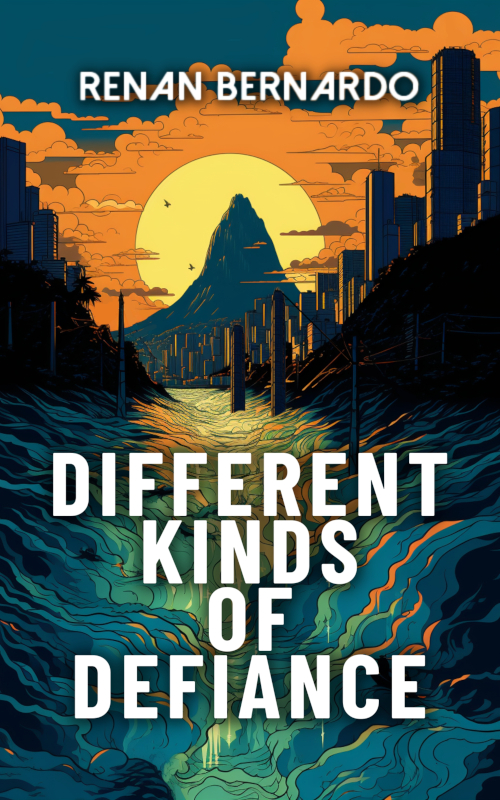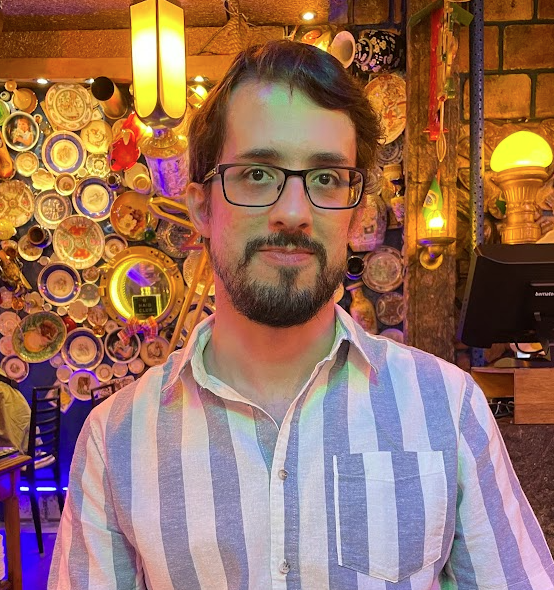Click here to return to the world eco-fiction series
About the Book

Renan Bernardo’s Different Kinds of Defiance (Android Press, March 2024) is a collection for the rebels at heart—for those who find courage where hope seems lost and for whom every act of resistance is an act of sheer will.
From the sunbaked docks of a Rio de Janeiro, changed yet still familiar, to the oil-streaked shores of Barra Nova, Renan Bernardo weaves tales of characters caught in the throes of life’s tempests. Meet Hamilton, whose pursuit of a stolen yacht morphs into a crusade for healthcare for the forgotten, his acts a mosaic of bravery and necessity. Walk with Vitória as she battles the relentless tide of pollution with a fleet of smart-bots at her side, her resolve as persistent as the oil that stains her beach. Stand by Jota, who faces the storms of parenting in the shadow of a past that is never quite done with him or his defiant bloodline.
I was fortunate to meet Renan at the Rewilding Our Stories Discord, a place to discuss ecologically oriented fiction around the world.
Chat with the Author
Mary: Thanks for joining Dragonfly.eco’s world eco-fiction series. We’ve not virtually traveled to Rio de Janeiro before, and when I started reading your latest book, Different Kinds of Defiance, I knew it was time. Can you talk about experiences that led you to write this book? I realize it’s made up of short stories appearing in various places, but the book seems thematically robust.
Renan: Thank you for having me here in Dragonfly.eco! It’s a pleasure.
I believe that several experiences have led me to write the stories that compose Different Kinds of Defiance. I’ve been writing solarpunk and climate fiction for years now, with a great focus on the anxieties and conflicts of the Global South, particularly Brazil. After I published several of the stories that are featured in the collection, I realized it was time to put them all together. Lots of them fit very well with each other, thematically speaking. There are several themes inherent to most or all of these stories—resilience and the search for an equitable world post-catastrophe are some of the cores that pervade these stories. In them, I explore themes like mass migration after a climate catastrophe, the reshaping and reconnection of severely impacted communities, intergenerational trauma and healing, redistribution of resources, and what an utopian world means—and what it doesn’t.
I’ve been reading this genre fiction throughout the years, and one thing I always seem to find is that most of them are US-centric, or at least focused on the English-speaking world/Global North. I agree that we will all share the same fate and suffer from the same afflictions when it comes to the climate crisis, but I clearly see it happens in different degrees. Underprivileged places tend to get a lot more flak when the damage is done. Many of things that will happen (that are happening) will be irreversible and will demand a lot more effort to rebuild—hence, will demand more resilience. It’s not about comparing afflictions (that’s horrible), but about understanding that part of the world has been hoarding lots of resources for centuries, and this will reflect on who will be the most impacted.
I try to bring this up in my fiction but with swathes of hope as well. I believe that we can and will (at some extent) avert the worst if we act on this together. And there are several ways of doing that—several ways to be defiant against the status quo and turn the world into a better place, or at least into a livable, tolerable place even after bad things happen. That’s what I want to convey with the stories in the collection.
Mary: The pleasure is mine! What do solarpunk and climate change fiction do for us, and how are they important to you?
Renan: Most of all, they bring awareness. Fiction has always been a doorway into science and history. In the golden age of science fiction, lots of the fears about the time were brought up by authors when they wrote about the atomic bomb or the horrors of a nuclear war in their stories. These made-up worlds brewed with ideas to revert the damage done, to prevent them—or just to show that there wasn’t a way out (but there was, in the end). During the 80s and after, cyberpunk and other subgenres of the so-called “soft SF” raised awareness about megacorporations accumulating power and wealth and how they could reshape society at their will.
And now, solarpunk and climate fiction can both raise awareness about what’s happening with the world and how to deal with that both individually and societally. But not only that, but I think solarpunk (or hopepunk), in particular, can do more than warn about something (be it a “big issue”, like the sea level rise, or a “individual issue”, like what eco-anxiety can do to a person). Solarpunk can bring hope and shows us that there are ways to heal, to resist, to rebuild, to prevent, and to carry on. That’s how these subgenres are important to me.
Mary: Do you have any interesting backgrounds for any of the stories? Or any favorites among the collection?
Renan: It’s hard to pick a favorite. It’s like picking a favorite child or a favorite dog. 🙂
But I can mention “Anticipation of Hollowness” because it’s the one that has been walking around the most. It’s a novelette about a girl named Janet living in a profoundly gentrified city called Sundyal, which inadvertently cast out all those who couldn’t afford to reside in it. Janet lives with her friend Lyria, an android with an upcoming expiry date. Janet knows she’ll lose her friend, the only one capable of keeping her sane in this beautiful, sustainable, but unlivable city. The main theme in this one is gentrification and how inclusive actions have to be all-encompassing. It’s my way of critiquing the supposed “green” or “smart” cities that some billionaires claim will be the future.
This story has been reprinted three times in English, translated to Portuguese (by myself) and Italian, published in audio (in English and Italian) and in comic books (in English and Italian as well).
Mary: Your place-writing is stunning. Is Rio de Janeiro your home?
Renan: Yes, I live here and have my whole life. Rio is inspiring to my stories in several ways. It has a web of complexity in its people, their ways of living, social classes, and the city’s urban shaping, that is both chaotic and planned. It has a profound history that mixes our colonial, imperial past with the exploitation and enslavement of African and Indigenous populations, and then the city’s rise as the Brazilian capital in the early 20th century (it’s not the capital anymore). It’s a fairly intense place in many ways but also incredibly welcoming. I hope I can show some justice to it in my stories that are set on it.
Mary: Your characters are genuine and identifiable. I see what the book description means when it says these people are everyday people. Can you describe how you write characters so well?
Renan: It took me several years to learn how to properly flesh out characters in fiction. I believe you say I write them so well because I tend to bring multiple layers to them. We all are multi-layered creatures navigating through life, and I try to make it clear with my characters. Sometimes they’re not the hero people are expecting them to be—they’re afraid, exhausted, traipsing through life, and just don’t want to save the day.
One aspect of my fiction that sometimes stands out to readers is that I have a bunch of characters who are surviving, not being agents of their own lives or necessarily “driving the plot forward”. This is particularly important in narratives that come from the Global South, mainly when I want to show how life is for real people. In the collection you’ll find characters desperately wanting to do something to change their world, but you’ll also find those people who are just trying to make ends meet—and their stories matter as well.
Mary: I found the relationships among hardship, determination, and strength ultimately tied to positive action that can redeem and give us hope. Can you tell us why this is so important right now?
Renan: Because that’s how we’ll move forward from now on if we want the status quo to be anything different from what it is. We’re part of a set of generations that have to relearn how to navigate life and that includes awareness, determination, and fighting, plus a lot of politics as well, though people don’t like to hear it. Hope is often a word that is associated with a silent passiveness, with waiting for good things to come, but I think it has so much more to it. Hope leads to action and to defiance. If you envision a better life in any degree, then you have hope, and if you have hope, then you have the driving force that leads to action and change.
Mary: Anything else that you want to add?
Renan: I wish big publishers paid more attention to climate fiction and solarpunk narratives from all over the world. Those are subgenres of speculative fiction that carry strong roots of local cultures and how they stand in the face of climate crisis. And, as I said, I believe that reading these types of stories brings awareness on a whole lot of issues, and publishers really have a say when it comes to amplifying voices.
Mary: Thanks so much, Renardo! Your book was excellent, well-paced, and so immersive.
About the Author
Renan Bernardo is a Nebula finalist author of science fiction and fantasy from Brazil. His fiction has appeared at Reactor/Tor.com, Apex Magazine, Podcastle, Escape Pod, Daily Science Fiction, Samovar, Solarpunk Magazine, and others. His writing scope is broad, from secondary world fantasy to dark science fiction, but he enjoys the intersection of climate narratives with science, technology, and the human relations inherent to it. His solarpunk/clifi short fiction collection, Different Kinds of Defiance, was published in 2024. His dark sci-fi novella, Disgraced Return of the Kap’s Needle, is upcoming by Dark Matter Ink.
He can be found at Twitter (@RenanBernardo), BlueSky (@renanbernardo.bsky.social) and his website.
